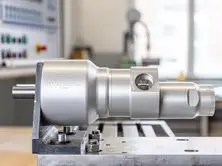
Air Motor driven PUMPS, MIXERS and CONVEYORS
In many applications like wet, dirty or potentially explosive areas or areas without electricity an air motor driven equipment is a good option. They are small, run cool, can be stalled, have high start torques, are available in sealed and stainless-steel versions and some have ATEX approvals for use in hazardous areas. Pneumatic diaphragm pumps can be difficult and expensive to repair and may not be suitable for heavy duty operation, pumping dirty fluids or to drive a hydraulic pump for example. Sealed or ATEX approved electric motors can be expensive and are often much larger than standard motors.
Typical air motor driven pumps, mixers and conveyors do have some design challenges.
Air motors are very expensive to run on long duty cycles. A typical 1kW vane powered air motor would need a 10kW compressor to run continuously. The energy costs will definitely add up over time.
The other issue in using an air motor to drive these applications is that air motors load specifications are rated at around half of their idle speed. The motor will spin at up to double its rated speed as the load decreases. For example, a 3kW pneumatic motor could produce 3kW at 1500rpm, however, if there is no load, the motor will run at 3000rpm. Therefore, if there is low load on the equipment, a vane motor will run at up to twice it’s rated speed, which increases air consumption to 130% of the rated consumption and can damage the pump, conveyor, mixer and even the motor. When using a vane motor on this type of equipment we need to decide how to mitigate the low load situation by either introducing a shutoff circuit or by throttling the motor to limit the speed, thereby also reducing its performance.
DEPRAG (Germany) has over 80 years of experience in air motor design and manufacture. Over that time the industrial air motors have developed from piston motors to the current modern vane motors. Vane motors are simple and cheap to maintain, and they are smaller and lighter than piston motors.
The basic principle of vane motors has not changed much in the last 40 or more years. They all have the issue of doubling the rated speed if there is low or no load. High-quality modern vane motors can have better air consumption, but all vane motors need regular maintenance and last longer with lubrication. The vanes spin around in the motor and eventually wear themselves and the internal parts of the motor out.
DEPRAG’s Turbine powered solution
DEPRAG’s new range of ATEX approved turbine powered air motors addresses all the above concerns, they offer a significantly more efficient solution, and they include a speed governor which keeps the speed constant and automatically reduces the air consumption when there is low load.
DEPRAG’s Turbine powered motors are 40% more efficient than a standard vane motor when operating at load. Furthermore, they have an integrated speed governor which limits the idle speed to 118% of the loaded speed and further reduces the air consumption under no load conditions. These features offer enormous energy and design savings on long duty cycle applications like pumps, conveyors and mixers.
DEPRAG’s turbine motors do not require lubrication. There are no vanes or contact parts inside the motor, the only wear parts are the gearing and the bearings as long as the air supply is very clean.
This range of motors is ATEX approved for potentially explosive areas and are fully sealed so external water and dust cannot enter the motor. The gearing uses USDA approved food grade grease. They are available in 1.5, 3.0 and 4.5kW versions with a selection of 8 different integrated gear boxes. The flange is a standard IEC flange and we also have a 1” drive selection available.
Download our catalogue here: Turbine Motor Catalogue
Please NOTE:
- Turbine motors are not available as reversible motors so the turn direction must be specified with an order
- Air supply must be very clean and water free (dew point of -20 DegC or the air should be pre-heated) otherwise the motor will be damaged
- Due to the high efficiency of air turbine motors, the exhaust air will be extremely cold, so it must be directed away from people or sensitive equipment. Ice will form outside of the motor or exhaust pipes, especially if used for long periods of time under full load conditions.